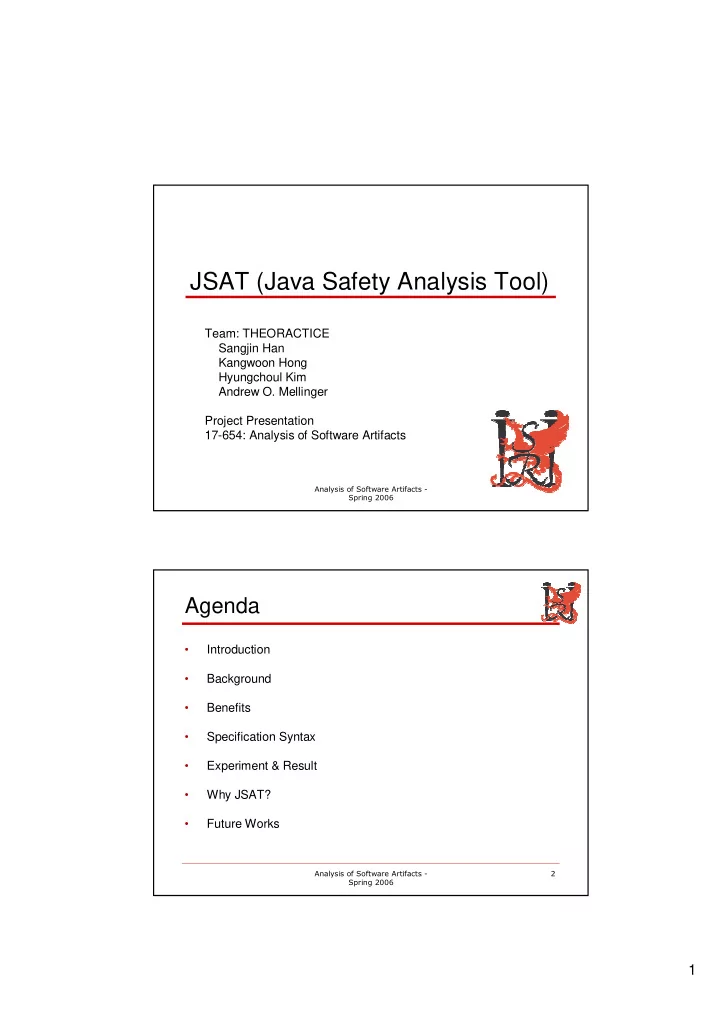

JSAT (Java Safety Analysis Tool) Team: THEORACTICE Sangjin Han Kangwoon Hong Hyungchoul Kim Andrew O. Mellinger Project Presentation 17-654: Analysis of Software Artifacts �������������������������������� � ����������� Agenda • Introduction • Background • Benefits • Specification Syntax • Experiment & Result • Why JSAT? • Future Works �������������������������������� � ����������� 1
Introduction to JSAT • Built on Crystal2 framework • Analyze Java source code statically • Check temporal safety property (i.e. check specification conformance of method implementation) • Modifiable and re-distributable (royalty-free… ) �������������������������������� � ����������� The JSAT System Parser + Safety Checker Parser + Safety Checker Syntax Analyzer (JSAT) Syntax Analyzer (JSAT) Specification Specification (*.sm files) (*.sm files) True or False True or False Java Source Code Java Source Code (*.java files) (*.java files) �������������������������������� � ����������� 2
Theoretical Background • Dataflow analysis • Finite state machine • Modular reasoning �������������������������������� � ����������� Benefits • Easier to code than writing own analysis. • Specification can be kept in separate file (i.e. don't need access to source code.) • Can track any number of variables or functions easily. • Light-weight and easy to write specifications (terms are based on UML statechart diagram) �������������������������������� � ����������� 3
Core Specification Syntax (1) :: = StateVariable a | , a StateVariable :: , Event = Pattern Guard | , Pattern Action | , , Pattern Guard Action :: = Pattern MethodInvocation :: Guard = Predicate | & & Predicate Guard �������������������������������� � ����������� Core Specification Syntax (2) :: = == Predicate a e | ! a = e | < a e | a > e | <= a e | >= a e :: Action = Assignment | , Assignment Action :: Assignment = a = e :: = e a | c variable a value c �������������������������������� � ����������� 4
Experiment & Result public class Device { global int lockStatus = 0; int nPackets; event { public void doWork() { pattern { smInit(); } smInit(); action { lockStatus = 0; } } if (nPackets >= 1) { event { smLock(); pattern { smLock(); } guard { lockStatus == 0 } smWritePacket(); action { lockStatus = 1; } } smUnlock(); } event { } pattern { smUnlock(); } guard { lockStatus == 1 } public Device(int i) { action { lockStatus = 0; } nPackets = i; } } LockUnlock.sm (Specification) Device.java (Java Source Code) TRUE �������������������������������� � ����������� Why JSAT ? ESC/JAVA Fluid PREfix Metal ESC/JAVA Can#Analyze#Java# [YES] Fugue Fluid Source#Code#? Daikon JSAT Echelon Blast JSAT Is# Annotation# ESC/JAVA [YES] Can#Analyze# Separate# Fluid Statically#? From#Source# JSAT Code [YES] JSAT �������������������������������� �� ����������� 5
Future Works • Extend pattern type • Accept more complex predicates • Allow symbolic state �������������������������������� �� ����������� �������������������������������� �� ����������� 6
Application of Eclat Serendipity Majid AlMeshari Lucia de Lascurain Steven Lawrance Ricardo Vazquez Hyunwoo Kim Project Presentation 17-654: Analysis of Software Artifacts �������������������������������� �� ����������� Agenda • Motivation • How does Eclat work? • Our Studio project • Our experiments • Analysis of experimental data • Lessons learned • Next steps • Questions �������������������������������� �� ����������� 7
Motivation • Writing test cases manually • Is time consuming • Requires deep understanding of the system’s invariants • Eclat generates test cases automatically by discovering system’s invariants �������������������������������� �� ����������� How does Eclat work? (1) �������������������������������� �� ����������� 8
How does Eclat work? (2) �������������������������������� �� ����������� Our Studio project • Objective: calculate security sensor positions in a 3D blueprint to maximize coverage and follow security rules. • To design our architecture, we developed experiments that calculate the coverage of sensors. • We used this code to analyze Eclat, as it is representative of our project. �������������������������������� �� ����������� 9
Our Experiments • Inject five defects into our code • Incorrect variable assignment • Incorrect guard, e.g. if ( y < z_size ) • Protocol violation • Incorrect parameter assignment • Off-by-one problem • Experiments • Run Eclat with partial test cases • Run Eclat with full test cases • Code review �������������������������������� �� ����������� Sample: Off-by-one problem (1) • Fault injected source code vox = (Voxel)enu.nextElement(); while (enu.hasMoreElements()) { if (vox.getRed()==red && vox.getGreen()==green && vox.getBlue()==blue && vox.getAlpha()==alpha) volume++; vox = (Voxel)enu.nextElement(); } �������������������������������� �� ����������� 10
Sample: Off-by-one problem (2) • Input test case (r,g,b,a) color (x,y,z) coordinate • VoxelSpace voxelSpace = new VoxelSpace(2, 2, 2, 2.2); • voxelSpace.color(248, 40, 241, 128, 0, 0, 0); • voxelSpace.color(248, 40, 241, 128, 0, 0, 1); • voxelSpace.color(248, 40, 241, 128, 1, 0, 0); • voxelSpace.color(248, 40, 241, 128, 1, 0, 1); • voxelSpace.color(248, 40, 241, 128, 0, 1, 0); • … // nothing that affects (248, 40, 241, 128)’s coordinates • voxelSpace.color(248, 40, 240, 128, 0, 1, 0); • assertTrue(voxelSpace.getVolume(248, 40, 241, 128) == 4); • Assertion Failure �������������������������������� �� ����������� Sample: Off-by-one problem (3) • Eclat-generated test case • cmu.voxeltoy.VoxelSpace var180 = new cmu.voxeltoy.VoxelSpace(2, 2, 1, (double)-5.0); • … // nothing that sets a voxel’s color • int var422 = var180.getVolume(0, 0, 0, 0); • NoSuchElementException �������������������������������� �� ����������� 11
Sample: Off-by-one problem (4) • Manually-constructed test case • Found the case where the returned volume is off by one due to failure to include the last voxel • Eclat-generated test case • Found the case where an empty voxel space throws an exception instead of returning zero • Eclat found a test case that a seemingly- comprehensive test suite missed �������������������������������� �� ����������� Analysis of Experimental Data Eclat: Partial Eclat: full test Code review test cases cases Input test cases 2 10 N/A Generated test 29 85 N/A cases False positives 0 1 0 False negatives 2 0 2 Unexpected 4 4 0 errors found �������������������������������� �� ����������� 12
Recommend
More recommend